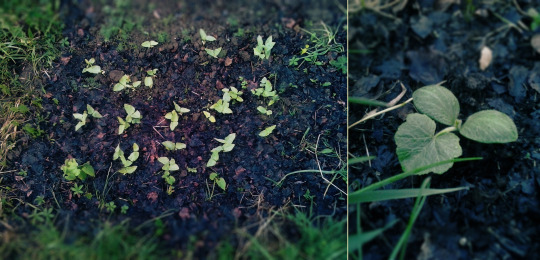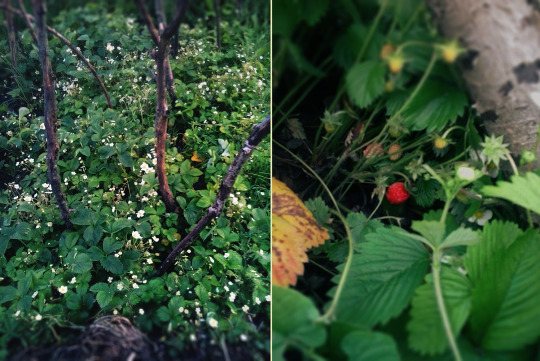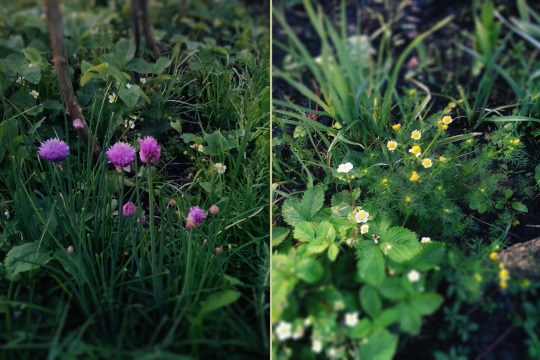#growing chives
Text
Tips for Successfully Planting Chives in Your Garden

Discover the delightful world of planting and growing chives, nature's perennial herbs that are as attractive in your garden as they are in your meals. Planting chives is a simple and rewarding gardening experience that even beginner gardeners can enjoy. If you've wondered, "How do you plant chives?" then this detailed guide will provide you with everything you need to know. Chives not only add a lovely onion-garlic taste to dishes but also embellish your garden with their small, dainty, purple flowers. Join us as we delve into the techniques, tips, and tricks of successfully growing chives so you can experience their vibrancy and flavor right from your very own garden.
How Do You Plant Chives?
So, you've decided to try your hand at growing chives! Congratulations, you're in for a flavorful treat. Chives are a versatile herb that can add a pop of freshness to a variety of dishes.
First things first, chives thrive in well-drained soil and plenty of sunlight. Find a sunny spot in your garden or on your balcony where your chives can soak up the rays. Make sure the soil is rich in nutrients.
Remember, chives are part of the onion family, so they don't like to be overcrowded. Give them plenty of space to spread out and grow. They also don't need a lot of water, so be careful not to overwater them.
When planting chives, you can start from seeds or buy seedlings from your local nursery. If starting from seeds, sow them directly into the soil or in small pots indoors. Keep the soil moist but not waterlogged as the seeds germinate.
Once your chives have sprouted and have a few inches of growth, you can start snipping off the leaves for culinary use. Regularly harvesting chives will encourage new growth and keep the plant healthy. Remember to leave at least 2 inches of growth so the plant can continue to thrive.
Chives are a low-maintenance herb that can be grown by gardeners of all levels. Whether you have a green thumb or are just starting out, chives are a great addition to any herb garden. Happy planting!
For more tips on growing chives, check out this related article.
Learn more about gardening with Taim.io!
0 notes
Text
Indoor Culinary Herb Garden: 5 Types of Chives to Grow for Unique Flavors
Chives are one of the most popular culinary herbs that are used in a variety of dishes such as salads, soups, stews, and more. They are easy to grow and maintain, making them an excellent choice for indoor herb gardens. There are several varieties of chives that can be grown indoors, each with its unique flavor and appearance. In this blog post, we will discuss the different kinds of chives that…

View On WordPress
#chives#garlic chives#growing chives#herb garden#herbs#indoor herb garden#indoor herb gardening#indoor herbs#unique flavors
1 note
·
View note
Text


🖤✨
#green witch#lunar witch#witchyvibes#gemini#witchy blog#magic#witchcraft#baby witch#herbs#herbs you can grow inside#basil#bay#chives#dill#lemon grass#mint#oregano#parsley#rosemary#sage#thyme
11 notes
·
View notes
Text
Seeing posts from people in warmer climate zones is making me lose mIND I wanna plant things in the dirt so bad but there's still like half a foot of snow outside here!
#when my chives awaken from their winter slumber#then finally i will know peace#gonna make this garden grow
37 notes
·
View notes
Text
OH OH OH did i tell yall about my new cacti?? i added them to my wide pot with my aloe and eeeeeeeeee it looks so much better now!!!!
#lil miss aloe got baby sisters!!!!!#i gave my sage some uhhhhh growing sticks too?? poor thing was v floppy so shes got some support now#and chive has been growing strong ever since i planted her im v proud my last ones never made it past a couple months#she probably will wilt when it gets colder but that is what it is but sage is evergreen#and if i just move the wide box away from the window over the cold period then the cacti and aloe will be good too
3 notes
·
View notes
Text
Garden update and slug damage
So, since it's been raining for a while and I haven't been able to get to the garden to pick off slugs at first, when I finally did get to it, I had found some damage! My genious plan to plant beans directly into the strawberry patch seemed foolproof. However, it seems that slugs had also been, in the strawberry patch, waiting for strawberries and multiplying, and their favourite food, is beans. So some of my beans ended up looking like this:

If a baby plant gets all of her first leaves eaten off like this, she can't survive, so that kills it completely. This isn't the first time this happened to me, so I was ready for it – I saved some of the seeds of every bean, just in case something happened, and I can re-sow them after the rain has passed. Here is the culprit on the third picture!
A neighbour gardener had told me that these brown slugs are not native to the area, and that they've in fact been imported from america. She added that it had been done on purpose, to destabilize our crops, in a conspiratorial voice. She has been very outspoken anti-american activist, and in fact so focused on blaming americans for everything, that I worry she's missed a very real problem on the balkan: the slavic people. So I don't know how much I trust her story. But, I can see that these slugs outnumber the white slugs by 50:1, and that they eat everything, I've seen them eating even nettle. They'll go and take bites out of tomatoes, they're not shy of getting poisoned. I wonder if anyone knows the accurate lore of this slug?
(I looked it up, the slugs got imported accidentally, with vegetable imports from Portugal and Spain in 1950s, it's called the 'spanish slug' and it spread over all Europe)
Anyway, not all beans have been ruined! In some areas with less strawberries, they've been growing just fine:

And I'm picking slugs off every evening, and relocating them to the wilderness. Hopefully nothing else will get badly damaged!

The rain has made a difference in tomatoes; the first picture shows a tomato I've planted out weeks ago, it already got used to the cold and the wet, it already figured out how to draw nutrients from the soil and it's growing quite nicely! The other tomato, the purple one, has been only recently planted, and immediately turned purple because of the rain. I got it used to the cold, but then it got colder, and it couldn't draw nutrients in colder weather, that's why it's purple, it's a nitrogen deficiency and cold protest. It's going to recover with sufficient sun and fertilization, I had a few like this and they all recovered just fine. Even 2 days of sunshine would fix this!
The rest of the garden is doing fine! Here's some pictures:





#garden update#growing food#gardening#community garden#self grown food#spring garden#slug damage#rain garden#beans#green beans#squash#strawberries#potatoes#peas#cabbage#chives#chamomile
19 notes
·
View notes
Text
I had to buy a lot of spices this weekend and I was like, god damn, when did spices get so expensive, but then it's like. My dude, you've been reading about 18th century piracy and spices are one of the valuables that got stolen, would you like to reconsider your point of view on the matter.
(The answer is no because grocery prices are unquestionably absurd, but sometimes you have to consider whether your complaint is unreasonable.)
#please god can the warm weather get here though#i need to be growing herbs instead of buying them#(my chives came back last week!)#(i have to haul them out of the garage tomorrow when it's warm)
4 notes
·
View notes
Text
what herbs should i plant?
2 notes
·
View notes
Text
FINALLY after almost a year turned our old extra snake tank into an herb container garden.... just gotta wait for the grow lights to come in >:3c

#too many mint family members to plant them even remotely together#I'm ngl that mint does NOT need a grow light. I'm gonna put it somewhere else soon#maybe make some room for chamomile or mugwort or chives.......
5 notes
·
View notes
Text
thinking about getting one of those window sized hydroponic grow systems. just big enough I can grow some fresh herbs. the warm weather is making me impatient to start gardening lol
#Amazon has a small one for just 40 bucks#thinking of maybe growing some parsley chives and basil#we’ll see what else I can fit in it not sure how much exactly
5 notes
·
View notes
Text
planted parsley seeds today. here's hoping they germinate before March. :)
#parsley seed joke. they take a while is all.#the chives were starting to show radicles this morning but we left them in the germ chamber Just In Case.#it's only like 65-70*F in there. just warm enough to keep the humidity basin going.#I think last time we took them out too soon and they all went sleepies in the chill. bastards. wake up and grow leaves. I'll fight you.#edit- SPELLING...
3 notes
·
View notes
Text

My sister’s house is but one big iSpy book
#that’s it#and she grows her own chives#utter chaos#utter sanity#cow#tiny army men#2 oranges#gargeil mug#unidentified plant in tiny cup#lots of frogs
5 notes
·
View notes
Text
* thinks about the agriculture and cuisine of fantasy races *
#elves use more herbs while dwarves use more spices#because the growing season in the mountains is shorter so they wouldn’t have and much fresh greenery to rely on#whereas spices are made of seeds instead of leaves#which can be more easily dried while retaining their potency#though elves would use both fresh and dry herbs as well as the occasional spice#dwarves use mostly spices and a good deal of salt#halflings use lots of herbs as well but get most of the flavoring from their cooking from fresh alliums#like garlic and leeks and chives
4 notes
·
View notes
Text
GROWING HERBS IN JARS

If you have a glass jar and access to fresh water, you can grow a supply of herbs right on your windowsill! While any medium-sized container will do, Mason jars are particularly cute! You could also head to your local thrift store and stock up on a few decorative glasses for cheap.
The next step is to choose the right herb. Check out this list of 12 herbs you can grow in water. This hard-to-mess-up method is a great option for the busy bee who doesn’t have time (or the desire) to deal with soil.
1. Peppermint
Grow peppermint in a jar and snip off a bit to make herbal tea, oil or soup. You can also just enjoy the sweet scent of this fragrant herb. Peppermint does well in partially sunny or shady windows.
2. Oregano
You can use fresh oregano straight in pasta sauces, soups and other savory dishes. Just use a pair of kitchen scissors to gently remove a few leaves from the stem. Oregano can grow quite large, so keep an eye on your plant.
3. Sage
Sage has a flavorful scent which makes it a popular choice for holistic purposes. You can also use sage with eggs, chicken, lamb or pineapple. Snip as much as you need and add it to your favorite dish. Sage doesn’t need a ton of water and should be kept in moderate sunlight.
4. Basil
This popular Italian herb grows well in water and can be used in many different recipes including sauces and soups. Make sure your basil jar gets about 6 to 8 hours of sunlight per day.
5. Stevia
This hardy herb prefers a bit of sun but can grow just as well in shadier areas. You can use the leaves off of this herb to sweeten your tea of coffee naturally! You can also create a powder from the leaves to use as a sweetener.
6. Thyme
Thyme is a versatile herb. It will flower, and the flowers are edible. You can also harvest it before it flowers, hang the stems to dry the leaves and then remove the leaves to use in cooking. Thyme needs plenty of sunlight, so set those jars in a bright window.
7. Rosemary
This flavorful herb does well in sunlight or partially shaded areas. It will grow better in full sunlight though. Use your growings to spice up your favorite chicken dish!
8. Lemon balm
You can use the lemon balm herb to create an herbal tea that helps reduce anxiety, relieve symptoms of indigestion and helps make sleeping a little easier. Give this plant plenty of sunlight.
9. Chives
This onion family member is super easy to grow, and you can use it in a ton of dishes. Make sure this herb has plenty of water and sunlight for best growth results.
10. Cilantro
Cilantro prefers plenty of sunlight, though partial shade works okay too. Use this flavorful herb to add an extra punch to your salsa and other Mexican-inspired dishes.
11. Lavender
Lavender can be used to soothe depression symptoms, ease migraines and cramping and promote better sleep. Use lavender leaves to make a tea or an oil. Added bonus: lavender smells fantastic! This herb needs the sun and fresh air to thrive, according to Bonnie Plants.
12. Marjoram
This herb does really well indoors, though it grows best in full sunlight. This herb is a bit slower to grow, so you may need a little patience. Use this herb to spice chicken and beef dishes. Some people prefer to create an oil for lotions and bath soaps too.
#junko on the farm#gardening#garden#herb garden#herbs#fresh herbs#mason jars#hydroponics#grow#aquaponics#organic#homesteading#peppermint#basil#rosemary#oregano#chives#lavender#lemon balm#sage#stevia#thyme#cilantro#marjoram
7 notes
·
View notes
Text
Behold: my side of the windowsill in my dorm room.

#plants#I have more at home#and one more hanging off my bed#one pot is empty because my chives refuse to grow :(
2 notes
·
View notes
Text
quarter life crisis is demanding that i try growing peppers again so pray for my seedlings lads
#used to grow them with my mom as a kid#lotta jalapenos. some sort of small thai(?) chilis#started some chives to#ree talks
2 notes
·
View notes